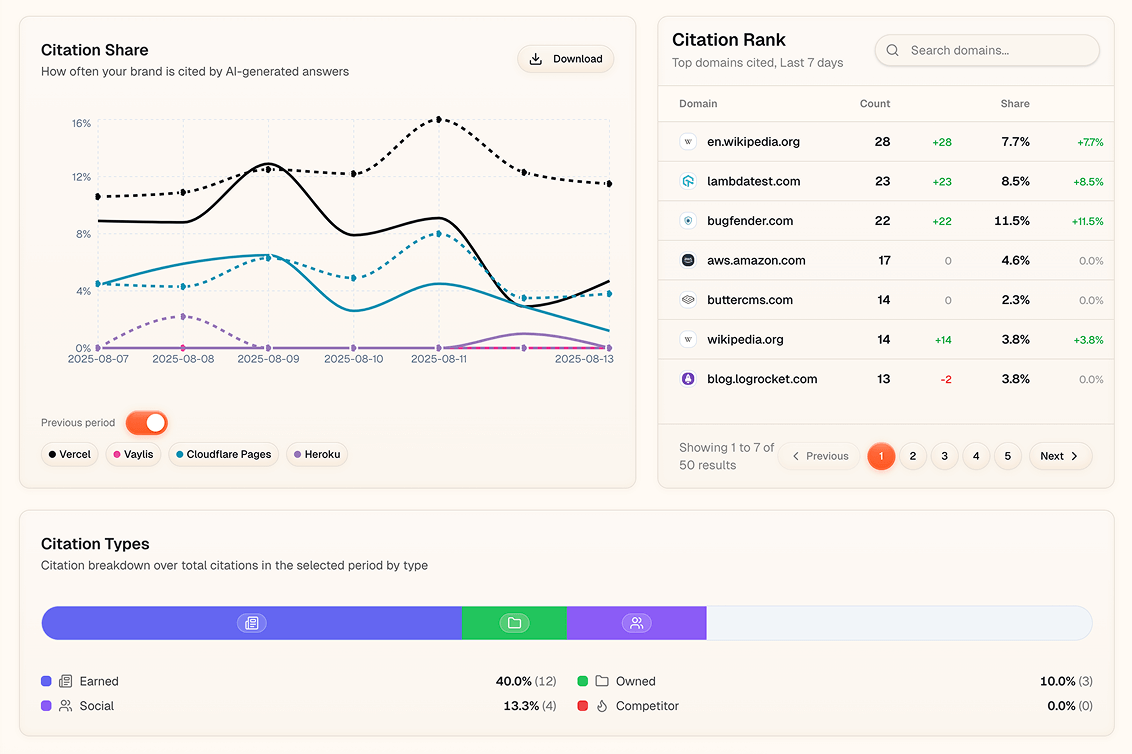The Voice Search Explosion
Voice search isn't just a trend - it's becoming the dominant way people interact with technology. In 2025, voice commands account for over 50% of all searches on mobile devices.
But voice search optimization goes beyond just speaking keywords. It requires understanding conversational AI and how people naturally ask questions.
Why Voice Search Changes Everything
1. Natural Language Processing
Voice search uses full sentences and conversational language:
- "Hey Siri, what's the best Italian restaurant near me?"
- Not: "Italian restaurant near me"
2. Conversational Context
Voice searches often happen in context:
- Follow-up questions: "What's their phone number?" (referring to the restaurant)
- Multi-turn conversations: "Book a table for 4 at 7 PM"
3. Intent Clarity
Voice searches reveal true user intent:
- "I need running shoes for marathon training"
- Not just: "running shoes"
The Conversational AI Revolution
1. Beyond Simple Answers
Conversational AI maintains context across multiple interactions:
- Remembers previous questions
- Builds on prior knowledge
- Provides personalized responses
- Engages in back-and-forth dialogue
2. Multi-Modal Responses
Conversational AI combines multiple types of responses:
- Voice answers with visual confirmation
- Text responses with audio playback
- Interactive elements and actions
3. Proactive Assistance
AI anticipates user needs and offers help:
- "Would you like me to check the weather for your trip?"
- "I noticed you asked about restaurants - here are some nearby options"
Voice Search Optimization Strategies
1. Question-Based Content
Structure content around natural voice queries:
Before: Keyword-focused titles
- "Best Running Shoes 2025"
After: Question-focused content
- "What are the best running shoes for marathon training?"
- "How do I choose running shoes for my foot type?"
2. Conversational Content Structure
Create content that matches voice search patterns:
- Featured Snippets Optimization: Position key information first
- Conversational H2s: Use question-based headings
- Natural Language: Write conversationally, not robotically
3. Local and Contextual Focus
Voice searches are inherently local and contextual:
- "Find a coffee shop open now"
- "What's the traffic like on my commute?"
- "Show me restaurants within walking distance"
Conversational AI Content Strategy
1. Topic Clusters with Conversation Flow
Build content that supports multi-turn conversations:
- Primary topic pages with comprehensive answers
- Related topic pages for follow-up questions
- FAQ sections anticipating user follow-ups
- Cross-linked content for deeper exploration
2. Personality and Tone Optimization
Match your brand's conversational personality:
- Professional Services: Authoritative but approachable
- Consumer Brands: Friendly and helpful
- Technical Products: Clear and educational
- Entertainment: Fun and engaging
3. Proactive Content Suggestions
Create content that AI can naturally suggest:
- "People also ask" style content
- Related question sections
- "You might also like" recommendations
- Contextual follow-up content
Technical Voice SEO Implementation
1. Schema Markup for Voice
Implement structured data that voice assistants understand:
{
"@context": "https://schema.org",
"@type": "FAQPage",
"mainEntity": [{
"@type": "Question",
"name": "How do I choose running shoes?",
"acceptedAnswer": {
"@type": "Answer",
"text": "Consider your foot type, running style, and intended use..."
}
}]
}
2. Voice Search Analytics
Track voice-specific metrics:
- Voice query performance
- Conversational completion rates
- Voice-to-action conversion
- Multi-turn engagement
3. Mobile-First Optimization
Voice search is predominantly mobile:
- Fast loading times
- Mobile-friendly content structure
- Touch-friendly interactive elements
- Location-based personalization
Conversational Content Formats
1. FAQ Pages and Sections
Structured question-and-answer content:
- Comprehensive FAQ pages
- Inline FAQ sections in articles
- Product-specific Q&A
- Service-related frequently asked questions
2. How-To Guides and Tutorials
Step-by-step conversational guides:
- "How to" articles with natural language steps
- Video tutorials with voice narration
- Interactive guides with voice prompts
- Progressive disclosure content
3. Comparison and Decision Content
Help users make choices conversationally:
- "Should I choose A or B?" content
- Pros and cons discussions
- Recommendation engines
- Personalized suggestion content
4. Story-Driven Content
Narrative content that engages conversationally:
- Case studies with dialogue
- User journey stories
- Problem-solution narratives
- Experience-based content
Voice Search Tools and Technology
1. Voice Search Testing Tools
Test how your content performs in voice search:
- Voice search simulation tools
- Natural language query testing
- Conversational flow analysis
- Voice assistant compatibility checking
2. AI Content Optimization
Use AI tools to optimize for voice:
- Natural language generation
- Question prediction algorithms
- Conversational content analysis
- Voice search ranking prediction
3. Analytics and Monitoring
Track voice search performance:
- Voice query monitoring
- Conversational analytics
- Voice assistant integration metrics
- Multi-modal performance tracking
The Future of Voice and Conversational SEO
1. Ambient Computing
Voice interfaces everywhere:
- Smart homes with constant voice interaction
- Wearables with always-on voice
- Automotive voice systems
- Public space voice assistants
2. Multi-Turn Conversations
More sophisticated dialogue management:
- Context retention across sessions
- Personalized conversation history
- Proactive suggestion systems
- Emotional intelligence in responses
3. Visual Voice Search
Voice combined with visual elements:
- "Show me that jacket in blue"
- "Find restaurants like this photo"
- "What song is playing in this video?"
4. Proactive AI Assistance
AI that anticipates and initiates conversations:
- "I noticed you usually order coffee at this time"
- "Your flight is delayed, would you like alternatives?"
- "You have a meeting in 30 minutes, need directions?"
Measuring Voice Search Success
1. Voice-Specific KPIs
Track voice performance metrics:
- Voice query volume and ranking
- Voice-to-click conversion rates
- Conversational completion rates
- Voice assistant brand mentions
2. Conversational Analytics
Monitor conversation quality:
- Conversation length and depth
- User satisfaction scores
- Task completion rates
- Follow-up question frequency
3. Business Impact Metrics
Measure real business value:
- Voice-driven conversions
- Voice-assisted sales
- Voice-enabled customer service
- Voice-enhanced user engagement
Implementation Strategy
Phase 1: Foundation
- Audit current voice search presence
- Set up voice analytics tracking
- Create initial FAQ and question content
Phase 2: Optimization
- Optimize high-value pages for voice
- Implement conversational content strategies
- Test voice search performance
Phase 3: Advanced
- Develop proactive conversational content
- Integrate with voice assistant platforms
- Implement AI-driven content optimization
Common Voice SEO Mistakes
1. Ignoring Conversational Context
Don't just add questions to existing content. Create conversationally.
2. Forgetting Mobile Optimization
Voice search is mobile-first. Desktop optimization isn't enough.
3. Neglecting Local Context
Voice searches are often location-based. Add geographic relevance.
4. Over-Optimizing for Assistants
Don't create content only for voice assistants. Humans read too.
5. Ignoring Multi-Turn Potential
Plan for follow-up questions and continued conversations.
The Voice-First Future
Voice search and conversational AI represent the next evolution of search. Users are moving away from typing to speaking, from searching to conversing.
The brands that succeed will be those that:
- Understand conversational user intent
- Create content that supports natural dialogue
- Optimize for voice assistant platforms
- Build conversational brand experiences
Voice isn't just another channel - it's becoming the primary interface for digital interaction.
Are you ready to speak your customers' language?
Frequently Asked Questions
How do I optimize my website for voice search?
Structure content around natural questions people ask. Use conversational H2 headings, position key information first for featured snippets, and focus on local, contextual content.
What percentage of searches are voice searches?
In 2025, voice commands account for over 50% of mobile searches. This number continues to grow as smart speakers and AI assistants become more prevalent.
How does conversational AI differ from traditional chatbots?
Conversational AI maintains context across multiple interactions, anticipates user needs, and provides multi-modal responses combining voice, text, and visual elements.
Should I still optimize for text-based search?
Yes, text-based search remains important. Voice optimization enhances rather than replaces traditional search optimization.
How do I measure voice search performance?
Track voice query rankings, conversational completion rates, and voice-assisted conversions. Use analytics tools that monitor voice-specific metrics.
What are the biggest challenges in voice search optimization?
Creating truly conversational content and understanding context-dependent queries. Voice searches often include follow-up questions and multi-turn conversations.



